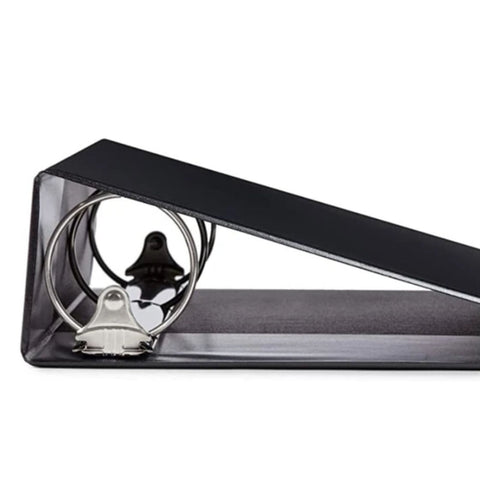Article: How To Choose The Right 3 Ring Binder | RingBinderDepot

How To Choose The Right 3 Ring Binder | RingBinderDepot

POINTERS FOR CHOOSING THE CORRECT RING BINDER FILE
The most frequently asked questions we at ringbinderdepot.com receive when it comes to our professional binders are:
"what ring size do I require?"
" What ring type is the best?" and
" What's the average storage capacity?".
So in today’s blog post, we aim to answer these questions for you.
1. Choosing The Right Ring Binder Ring Size For You:
The most common misconception is that the ring binder size is the width of the spine of the binder. However, that is not true. When you come across binder listing for products such as “3-inch 3 ring binders” the size “3-inch” is referring to the size of the binder ring.
Do note: As the ring must go around the contents for the box file to close, the overall size of the rings must be slightly larger than the stated inch-size.
Based on your storage size or the approximate capacity of pages required, you should be able to choose the right 3 ring binder for you.
2. Choosing The Right Ring Binder Ring Type For You:

Above image illustrates different standard 1 inch binder ring types.
There are three typical types of rings:
-
Round Ring Binders (O-Ring Binders): These are the traditional ring binders and the most common to come across. Here, the round rings are mounted to the spine of the box file causing your papers/ documents to not lay flat. They are ideal for documents that are not referenced too often.
-
D Ring Binders (Straight D-Ring Binders): D-Ring Binders can hold up to 30% more paper than a standard Round Ring Binder. To determine the sheet capacity of a D-Ring binder, always measure the straight part of the binder ring. Over here, the ring is mounted to the back cover, causing the pages to lie flat. They can be used for documents that are referenced often since the pages do not move and no stress is put on the papers.
- Slant – D Ring Binders (Angled D-Ring Binders): Very similar to the D-Ring Binders, the angled D-ring binders can hold up to 25% more paper than a standard Round Ring Binder. The ring is mounted to the back cover, causing the pages to lie flat. They are more durable than the straight D-ring binders. However, on average the slant-D ring binder holds about 5% fewer pages than the standard D ring binder.
3. Average Sheet Capacity Of Each Binder
2 factors come into play when calculating the number of pages a binder can contain (sheet capacity) – The size of the binder ring and the type of ring style.
The sheet capacity below is calculated using a standard A4 size sheet or 8.5" x 11" sheet size paper. The capacity mentioned below is the limit to which the binder closes comfortably. Therefore, in reality, the box files can accommodate more sheets.
RING BINDER SHEET CAPACITY CHART – ROUND RING BINDERS*
|
Ring Size |
Sheet Capacity |
|
1/2″ |
85 - 95 |
|
1″ |
170 – 190 |
|
1-1/2″ |
255 - 285 |
|
2″ |
340 - 380 |
|
3″ |
510 - 570 |
RING BINDER SHEET CAPACITY CHART – D-RING BINDERS*
|
Ring Size |
Sheet Capacity |
|
1/2″ |
110 - 120 |
|
1″ |
225 - 240 |
|
1-1/2″ |
335 - 360 |
|
2″ |
450 - 480 |
|
3″ |
675 - 720 |
RING BINDER SHEET CAPACITY CHART – SLANT-D RING BINDERS*
|
Ring Size |
Sheet Capacity |
|
1/2″ |
100 – 115 |
|
1″ |
200 - 230 |
|
1-1/2″ |
300 - 345 |
|
2″ |
400 - 460 |
|
3″ |
600 – 690 |
For more read click>>>>RocKey Safe: The Clever Key Hider That Blends Safety with Seamless Design
FAQs for Choosing the Correct Ring Binder File
Q1. What ring size do I require?
The ring size refers to the diameter of the rings within the binder, not the width of the spine. For example, when you see a product listed as "3-inch 3 ring binders," the "3-inch" refers to the size of the binder ring. Remember, the rings must be slightly larger than the stated inch-size to ensure they can go around the contents and close the file properly.
Q2. What ring type is the best?
There are three common types of ring binders: Round Ring Binders (O-Ring), D Ring Binders (Straight D-Ring), and Slant-D Ring Binders (Angled D-Ring). Each has its advantages. Round Ring Binders are traditional and suitable for documents not referenced often. D Ring Binders can hold more paper and allow pages to lie flat, making them ideal for frequently referenced documents. Slant-D Ring Binders are similar to D Ring Binders but are slightly more durable and can hold slightly fewer pages.
Q3. What's the average storage capacity of each binder?
The sheet capacity of a binder depends on the size of the rings and the type of ring style. For example, D Ring Binders can hold up to 30% more paper than Round Ring Binders, while Slant-D Ring Binders can hold up to 25% more paper than Round Ring Binders but slightly fewer pages than standard D Ring Binders. The sheet capacity mentioned is based on standard A4 or 8.5" x 11" sheet size paper, and the actual capacity may vary.

